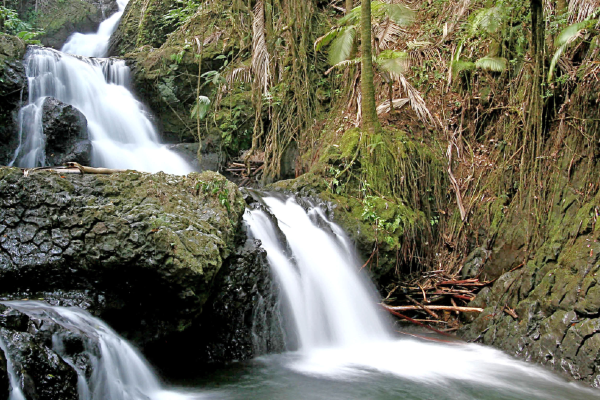Funding Hawai‘i’s Future Freshwater Resources
Watershed partnerships are helping to protect fresh water resources on Maui and across the state.

Deep in the Pu‘u Kukui Watershed Preserve in West Maui, a helicopter slowly descends toward a rugged stretch of ridgeline only accessible by air. It’s carrying a bundle of wire fencing that will be used to patch up a section of fence, making sure that invasive, feral pigs can’t break through and root up delicate, native plants from the soil.
Keeping Hawai‘i’s watershed areas protected is hard, unending work, but it’s something that’s made possible by watershed partnerships, which bring public and private landowners together to protect forests and aquifers across property lines.
Hawai‘i’s first watershed partnership formed in East Maui in 1991. The Nature Conservancy, Haleakala Ranch, East Maui Irrigation, Haleakalā National Park, and state and county foresters worked together to fence Waikamoi Preserve, a pristine native forest and one of the island’s most critical sources of captured rainwater.
Today, 10 watershed partnerships exist on five islands: three on Maui, three on Hawai‘i, two on O‘ahu, and one each on Kaua‘i and Moloka‘i. Together, they preserve and fortify sources of fresh water across more than 2.2 million acres, making them a crucial part of the effort to preserve Hawaii’s fresh water supply.
It’s an issue that’s only becoming more important as the years go by. Decades of drought, reduced rainfall, and population increases have put increased pressure on the sustainability of our water supply, and could even lead to water shortages in the future.
In order to study causes and find potential solutions, in 2013, the Hawai‘i Community Foundation (HCF) convened the Fresh Water Council. This advisory panel’s goal: to create 100 million additional, reliable gallons per day in Hawaiʻi’s daily fresh-water capacity by 2030.
“You accomplish that by doing things like water conservation measures, increasing water reuse, or recycling, and also by recharging groundwater. That’s where watershed partnerships come in,” says Dana Okano, program director of HCF’s Fresh Water Initiative.
As a way of supporting these organizations, the Fresh Water Initiative has worked to support the efforts of the Hawai‘i Association of Watershed Partnerships (HAWP). In December 2021, HCF funded HAWP to hire a statewide coordinator, and future plans include standardizing metrics across the watershed partnerships and hiring specialized technical staff.
For example, several partnerships don’t have a dedicated data person who can track the unique stats that field crews need to accomplish their critical work, such as deviations in rainfall patterns, stream locations, populations of native and invasive species, and places where it’s safe to land a helicopter.
Dan Eisenberg runs the East Maui Watershed Partnership and serves on the HAWP leadership board. He says, “Fundamentally, it comes down to ways to apply new technology to make our forest conservation work safer and more efficient,” says Eisenberg. “Our reach these days is impressive. But when we work collectively, with just a little more effort, we accomplish a lot more.”
Did You Know: Hawai‘i Community Foundation is committed to funding innovative programs and partnerships working to protect Hawaiʻi’s forests and preserve our freshwater resources.
Learn more at hawaiicommunityfoundation.org/strengthening/fresh-water
Read more Stories of Impact